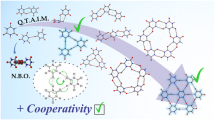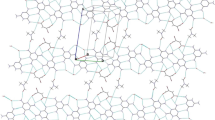Abstract
The melamine (M)/cyanuric acid (CA) supramolecular system is perhaps one of the most exploited in the field of self-assembly because of the high complementarity of the components. However, it is necessary to investigate further the factors involved in the assembly process. In this study, we analyzed a set of 13 M n /CA m clusters (with n , m = 1, 2, 3), taken from crystallographic data, to characterize the nature of the hydrogen bonds involved in the self-assembly of these components as well as to provide greater understanding of the phenomenon. The calculations were performed at the B3LYP/6-311++G(d,p) and ω-B97XD (single point) levels of theory, and the interactions were analyzed within the framework of the quantum theory of atoms in molecules and by means of molecular electrostatic potential maps. Our results show that the stablest structure is the rosette-type motif and the aggregation mechanism is governed by a combination of cooperative and anticooperative effects. Our topological results explain the polymorphism in the self-assembly of coadsorbed monolayers of M and CA.

The aggregation steps of the melamine-cyanuric co-crystal is driven by a hydrogen-bonded network which is governed by a complex combination of cooperative and anticooperative effects









Similar content being viewed by others
References
Seto CT, Whitesides GM (1993) Molecular self-assembly through hydrogen bonding: supramolecular aggregates based on the cyanuric acid-melamine lattice. J Am Chem Soc 115:905–916
Lindsey JS (1991) Self-assembly in synthetic routes to molecular devices. Biological principles and chemical perspectives: a review. New J Chem 15:153–180
Lehn J-M (2002) Toward complex matter: supramolecular chemistry and self-organization. Proc Natl Acad Sci U S A 99:4763–4768. doi:10.1073/pnas.072065599
Lehn J-M (1988) Supramolecular chemistry—scope and perspectives molecules, supermolecules, and molecular devices (Nobel Lecture). Angew Chem Int Ed Engl 27:89–112. doi:10.1002/anie.198800891
Manzano BR, Jalón FA, Soriano ML et al (2008) Multiple hydrogen bonds in the self-assembly of aminotriazine and glutarimide. Decisive role of the triazine substituents. Cryst Growth Des 8:1585–1594. doi:10.1021/cg7008682
Corradi E, Meille S, Messina M et al (2000) Halogen bonding versus hydrogen bonding in driving self-assembly processes. Angew Chem Int Ed 39:1782–1786. doi:10.1002/(SICI)1521-3773(20000515)39:10<1782::AID-ANIE1782>3.0.CO;2-5
Stupp SI, Palmer LC (2014) Supramolecular chemistry and self-assembly in organic materials design. Chem Mater 26:507–518
Choi IS, Li X, Simanek EE et al (1999) Self-assembly of hydrogen-bonded polymeric rods based on the cyanuric acid · melamine lattice. Chem Mater 11:684–690. doi:10.1021/cm980540j
Kerckhoffs JMCA, ten Cate MGJ, Mateos-Timoneda MA et al (2005) Selective self-organization of guest molecules in self-assembled molecular boxes. J Am Chem Soc 127:12697–12708. doi:10.1021/ja0536973
Kimizuka N, Kawasaki T, Hirata K, Kunitake T (1998) Supramolecular membranes. Spontaneous assembly of aqueous bilayer membrane via formation of hydrogen bonded pairs of melamine and cyanuric acid derivatives. J Am Chem Soc 120:4094–4104
Ma M, Gong Y, Bong D (2009) Lipid membrane adhesion and fusion driven by designed, minimally multivalent hydrogen-bonding lipids. J Am Chem Soc 131:16919–16926
Yagai S, Nakajima T, Karatsu T et al (2004) Phototriggered self-assembly of hydrogen-bonded rosette. J Am Chem Soc 126:11500–11508. doi:10.1021/ja047783z
Wang Y, Wei B, Wang Q (1990) Crystal structure of melamine cyanuric acid complex (1:1) trihydrochloride, MCA · 3HCl. J Crystallogr Spectrosc Res 20:79–84
Ranganathan A, Pedireddi VR, Rao CNR (1999) Hydrothermal synthesis of organic channel structures: 1:1 hydrogen-bonded adducts of melamine with cyanuric and trithiocyanuric acids. J Am Chem Soc 121:1752–1753
Prior TJ, Armstrong JA, Benoit DM, Marshall KL (2013) The structure of the melamine–cyanuric acid co-crystal. CrystEngComm 15:5838–5843. doi:10.1039/c3ce40709h
Seto CT, Whitesides GM (1990) Self-assembly based on the cyanuric acid-melamine lattice. J Am Chem Soc 112:6409–6411. doi:10.1021/ja00173a046
Zerkowski JA, Seto CT, Whitesides GM (1992) Solid-state structures of rosette and crinkled tape motifs derived from the cyanuric acid melamine lattice. J Am Chem Soc 114:5473–5475. doi:10.1021/ja00039a096
Seto CT, Whitesides GM (1993) Synthesis, characterization, and thermodynamic analysis of a 1 + 1 self-assembling structure based on the cyanuric acid·melamine lattice. J Am Chem Soc 115:1330–1340. doi:10.1021/ja00057a016
Chin DN, Gordon DM, Whitesides GM (1994) Computational simulations of supramolecular hydrogen-bonded aggregates: HubM3, FlexM3, and adamantane-based hubs in chloroform. J Am Chem Soc 116:12033–12044
Bielejewska AG, Marjo CE, Prins LJ et al (2001) Thermodynamic stabilities of linear and crinkled tapes and cyclic rosettes in melamine-cyanurate assemblies: a model description. J Am Chem Soc 123:7518–7533
Xu W, Dong M, Gersen H et al (2007) Cyanuric acid and melamine on Au111: structure and energetics of hydrogen-bonded networks. Small 3:854–858. doi:10.1002/smll.200600407
Ma M, Bong D (2011) Determinants of cyanuric acid and melamine assembly in water. Langmuir 27:8841–8853. doi:10.1021/la201415d
Frisch MJ, Trucks GW, Schlegel HB, Scuseria GE, Robb MA, Cheeseman JR, Montgomery JA Jr, Vreven T, Kudin KN, Burant JC, Millam JM, Iyengar SS, Tomasi J, Barone V, Mennucci B, Cossi M, Scalmani G, Rega N, Petersson GA, Nakatsuji H, Hada M, Ehara M, Toyota K, Fukuda R, Hasegawa J, Ishida M, Nakajima T, Honda Y, Kitao O, Nakai H, Klene M, Li X, Knox JE, Hratchian HP, Cross JB, Bakken V, Adamo C, Jaramillo J, Gomperts R, Stratmann RE, Yazyev O, Austin AJ, Cammi R, Pomelli C, Ochterski JW, Ayala PY, Morokuma K, Voth GA, Salvador P, Dannenberg JJ, Zakrzewski VG, Dapprich S, Daniels AD, Strain MC, Farkas O, Malick DK, Rabuck AD, Raghavachari K, Foresman JB, Ortiz JV, Cui Q, Baboul AG, Clifford S, Cioslowski J, Stefanov BB, Liu G, Liashenko A, Piskorz P, Komaromi I, Martin RL, Fox DJ, Keith T, Al-Laham MA, Peng CY, Nanayakkara A, Challacombe M, Gill PMW, Johnson B, Chen W, Wong MW, Gonzalez C, Pople JA (2004) Gaussian 03, revision D.01. Gaussian, Wallingford
Dey R, Bhattacharya B, Mondal P et al (2014) Fabrication of two supramolecular self-assemblies of Mn(II)-dicarboxylates with trans-4,4′-azobispyridine: analysis of H-bonding interactions with Hirshfeld surfaces and DFT calculations. J Mol Struct 1067:64–73. doi:10.1016/j.molstruc.2014.02.059
Scheiner S (2015) Dissection of the factors affecting formation of a CH⋯O H-bond. A case study. Crystals 5:327–345. doi:10.3390/cryst5030327
Duarte DJR, Sosa GL, Peruchena NM (2013) Nature of halogen bonding. A study based on the topological analysis of the Laplacian of the electron charge density and an energy decomposition analysis. J Mol Model 19:2035–2041. doi:10.1007/s00894-012-1624-8
Kirsch P, Tong Q, Untenecker H (2013) Crystal design using multipolar electrostatic interactions: a concept study for organic electronics. Beilstein J Org Chem 9:2367–2373. doi:10.3762/bjoc.9.272
Angelina EL, Andujar SA, Tosso RD et al (2014) Non-covalent interactions in receptor-ligand complexes. A study based on the electron charge density. J Phys Org Chem 27:128–134. doi:10.1002/poc.3250
Elango M, Subramanian V, Sathyamurthy N (2008) The self-assembly of metaboric acid molecules into bowls, balls and sheets. J Phys Chem A 112:8107–8115. doi:10.1021/jp8019254
Kannappan K, Werblowsky TL, Rim KT et al (2007) An experimental and theoretical study of the formation of nanostructures of self-assembled cyanuric acid through hydrogen bond networks on graphite †. J Phys Chem B 111:6634–6642
Boys SF, Bernardi F (1970) The calculation of small molecular interactions by the differences of separate total energies. Some procedures with reduced errors. Mol Phys 19:553–559
Chai J-D, Head-Gordon M (2008) Long-range corrected hybrid density functionals with damped atom-atom dispersion corrections. Phys Chem Chem Phys 10:6615–6620
Bader RFW (1994) Atoms in molecules: a quantum theory. Clarendon Press, Oxford
Keith TA (2012) AIMAll version 12.06.03. TK Gristmill Software, Overland Park. Available from http://aim.tkgristmill.com/
Bader RFW, Caroll MT, Cheeseman JR, Chang C (1987) Properties of atoms in molecules: atomic volumes. J Am Chem Soc 109:7968–7979
Wang Y-L, Mebel AM, Wu C-J et al (1997) IR spectroscopy and theoretical vibrational calculation of the melamine molecule. J Chem Soc Faraday Trans 93:3445–3451. doi:10.1039/a701732d
Drozd M, Marchewka MK (2005) The structure, vibrational spectra and nonlinear optical properties of neutral melamine and singly, doubly and triply protonated melaminium cations—theoretical studies. J Mol Struct THEOCHEM 716:175–192. doi:10.1016/j.theochem.2004.11.020
Li Z, Chen G, Xu Y et al (2013) Study of the structural and the spectral characteristics of [C3N3(NH2)3] n (n =1-4) clusters. J Phys Chem A 117:12511–12518
Bondi A (1964) Van der Waals volumes and radii. J Phys Chem 68:441–451
Lee HM, Singh NJ, Kim KS (2006) Weak to strong hydrogen bond. In: Grabowski S (ed) Hydrogen bonding - new insights Springer, Dordrecht, pp 149–192
Karpfen A (2003) Cooperative effects in hydrogen bonding. In: Prigogine I, Rice SA (eds) Advances in chemical physics, vol 123. Wiley, Hoboken, pp 469–510
Bader RFW, Beddall PM (1972) Virial field relationship for molecular charge distributions and the spatial partitioning of molecular properties. J Chem Phys 56:3320. doi:10.1063/1.1677699
Ramírez F, Hadad CZ, Guerra D et al (2011) Structural studies of the water pentamer. Chem Phys Lett 507:229–233. doi:10.1016/j.cplett.2011.03.084
Koch U, Popelier PLA (1995) Characterization of C-H-O Hydrogen bonds on the basis of the charge density. J Phys Chem 99:9747–9754. doi:10.1021/j100024a016
Vallejos MM, Peruchena NM (2012) Preferential formation of the different hydrogen bonds and their effects in tetrahydrofuran and tetrahydropyran microhydrated complexes. J Phys Chem A 116:4199–4210. doi:10.1021/jp301498n
Angelina EL, Peruchena NM (2011) Strength and nature of hydrogen bonding interactions in mono- and di-hydrated formamide complexes. J Phys Chem A 115:4701–4710. doi:10.1021/jp1105168
Popelier PLA (1998) Characterization of a dihydrogen bond on the basis of the electron density. J Phys Chem A 102:1873–1878
Angelina EL, Duarte DJR, Peruchena NM (2013) Is the decrease of the total electron energy density a covalence indicator in hydrogen and halogen bonds? J Mol Model 19:2097–2106. doi:10.1007/s00894-012-1674-y
Duarte DJR, Angelina EL, Peruchena NM (2014) Physical meaning of the QTAIM topological parameters in hydrogen bonding. J Mol Model 20:2510. doi:10.1007/s00894-014-2510-3
Cremer D, Kraka E (1984) Chemical bonds without bonding electron density ? Does the difference electron-density analysis suffice for a description of the chemical bond? Angew Chem Int Ed Engl 23:627–628. doi:10.1002/anie.198406271
Espinosa E, Molins E, Lecomte C (1998) Hydrogen bond strengths revealed by topological analyses of experimentally observed electron densities. Chem Phys Lett 285:170–173
Ofori A, Suvanto S, Jääskeläinen S et al (2016) Versatile coordination modes in silver-imidazolecarbaldehyde oxime complexes: structural and computational analysis. Cryst Growth Des 16:255–264. doi:10.1021/acs.cgd.5b01222
Acknowledgments
Grants from Secretaría de Ciencia y Tecnología, Universidad Tecnológica Nacional, Facultad Regional Resistencia supported this work. A.N.P. thanks Consejo Nacional de Investigaciones Científicas y Técnicas (CONICET), Argentina, for a doctoral fellowship. N.M.P. is a CONICET career researcher.
Author information
Authors and Affiliations
Corresponding author
Electronic supplementary material
Below is the link to the electronic supplementary material.
ESM 1
(PDF 626 kb)
Rights and permissions
About this article
Cite this article
Petelski, A.N., Peruchena, N.M. & Sosa, G.L. Evolution of the hydrogen-bonding motif in the melamine–cyanuric acid co-crystal: a topological study. J Mol Model 22, 202 (2016). https://doi.org/10.1007/s00894-016-3070-5
Received:
Accepted:
Published:
DOI: https://doi.org/10.1007/s00894-016-3070-5




